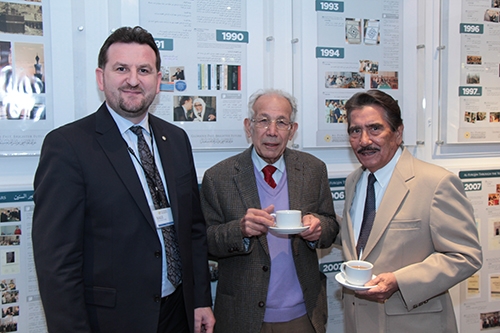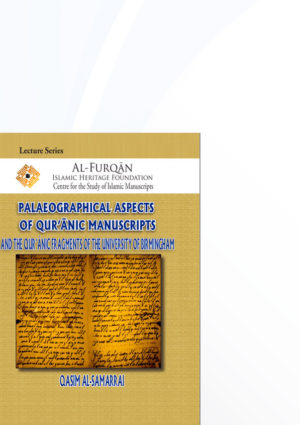In July 2015, when a PhD researcher looked closely at some fragments inside a more recent copy of the Holy Book (Qurʾān), it was decided to carry out a radiocarbon dating test.

The tests were carried out by the Oxford University Radiocarbon Accelerator Unit. These tests provided a range of dates. Hence, they showed that the parchment (sheep or goat skin) was from the period between 568 and 645 A.D.
Based on these results, researchers concluded that the manuscript was among the earliest written textual evidence of the Islamic Holy Book known to survive.
These pages of the Qurʾān had remained unrecognised in the Birmingham University Library for almost a century. The manuscript is part of the University's Mingana Collection of more than 3,000 Middle Eastern documents gathered in the 1920s by Alphonse Mingana, a Chaldean priest born near Mosul in modern-day Iraq. He was sponsored to take collecting trips to the Middle East by Edward Cadbury, who was part of the chocolate-making dynasty.

These four pages of the Qurʾān, in early Arabic script, sparked fierce debate among scholars.
The assertion that the document, kept at Birmingham University, is part of one of the world’s oldest copies of the Qurʾān is strongly disputed by many scholars in the field of codicology and palaeography, who point out that the science of carbon dating is contradicted by other evidence. Among these scholars is Qasim al-Samarrai, Professor Emeritus of Palaeography and Codicology (Leiden – Holland).
In order to shed light on this issue, Al-Furqān Islamic Heritage Foundation invited Professor Al-Samarrai to deliver a lecture on “Qurʾān Palaeography and the Fragments of the University of Birmingham”.
The event took place at the Foundation’s headquarters in London, on Monday 23rd November 2015. It started with welcoming words by Mr Sali Shahsivari, Managing Director of Al-Furqān, and Mr Sharaf Yamani, Member of the Board of Directors of Al-Furqān.

Professor Al-Samarrai started his lecture with an overview on the reaction of the media, as well as the academia world that followed the discovery of the Qurʾān fragments at the Birmingham University Library.
Then, after having inspected and thoroughly examined the two folios in the Birmingham Library, Professor Al-Samarrai commented with the following words: “The two folios appeared to me as palimpsests which were thoroughly and professionally washed out and on which another text of the Qurʾān was transcribed. The structure of the parchments under my own microscope does not appear to be older than the script itself. The two folios seemed to have been coated with a thick layer of Arabic Gum. The date when this had been applied I could not determine. In addition , the dotting of some letters like the tha', the shin and the nun and others with some diacritical signs like the fat’ha over some letters and five oblong dotes separating the ayats, indicate beyond any reasonable doubt that the folios belong to the end of the 2nd and the beginning of the 3rd century A.H., if not later”.
Furthermore, in relation to the Qurʾānic manuscripts in general, Professor Al-Samarrai highlighted five important facts:

1) Fact one: We possess no dated Qurʾān copy belonging to the first three centuries of Hijrah.
2) Fact two: We possess almost 250 thousand - if not more - fragments and various leaves of the Qurʾān, written on either parchments or papyrus, scattered all over the world, but not a single one bears a date. Thus, from this platform, I strongly challenge any scholar, working with the Qurʾān palaeography, and in particular those "revisionists", to produce one dated folio belonging to the span of time that lies between the year 40 A.H. (660 A.D.) and 300 A.H. (912 A.D.).
3) Fact three: The C14 test is doubtful due to the pollution in the atmosphere and the craft of manufacturing parchment in the East.
4) Fact four: The text of the Qurʾān depended from the beginning of the revelation, on memory, not writing; as one orientalist says: “The transmission of the Qurʾān after the death of Muhammad was essentially static, rather than organic. There was a single text, and nothing significant, not even allegedly abrogated material could be taken out nor could anything be put in.” Or, as one of the contemporary revisionists likes to put it: ‘’The Qurʾān was revealed in actual language, not in scriptural form. The script available at the time of revelation was highly defective (sic), so that it constituted little more than an aid for those who knew the text by heart already… being well aware that the oral tradition is the more important and valid one.’’
The oral tradition of the Qurʾān is a phenomenon very unique to Islam, in memorising the whole Book (Qurʾān); though we know that some Buddist monks recite some of their holy text in their sermons. There were, and still are, many millions of people who have memorised the Qurʾān, and millions of these have learnt the Qurʾān via a direct transmission, starting from the Prophet himself. They are enumerated with the chain of transmitters (isnāds) in the reciters’ (qurrāʾ) biographical sources; published or unpublished. It is, therefore, difficult to believe that, in some parts of the world, long religious texts are still memorised and transmitted from generation to generation, as it is in Islam.5) Fact five: In spite of all the information we gleaned from many sources at our disposal in connection with ʿUthmān’s copies, no copy belonging to ʿUthmān’s time ever survived; though many existing copies have been attributed falsely to him or to any individual contemporary of his.
The lecture was followed by several questions from the audience regarding different aspects covered by Professor Al-Samarrai.
Professor Qasim al-Samarrai
- 1958: BA (Hon) in Arabic Literature and History from the Faculty of Education, University of Baghdad.
- 1965: PhD in comparative mysticism (Ascension in Mystical Writings) from the University of Cambridge, UK under the supervision of Prof A.J. Arbery. At the same time, he held the post of lecturer at the Department of Oriental Studies, Cambridge University, UK.
- 1966 – 1969: Assistant professor at the Faculty of Sharīʿah and at the Faculty of Arts – Department of Philosophy of the University of Baghdad, as well as at al-Mustansiriyya University in Baghdad.
- 1970 – 1976: Held the post of lecturer of Arabic literature and Islamic History at the Department of Arabic & Islamic Studies of the University of Leiden, the Netherlands.
- 1977- 1980: Affiliated Professor to the Department of Islamic Studies, the Faculty of Theology of the University of Leiden, the Netherlands. - 1980-1981: Held the post of Professor of Islamic Philosophy at the Faculty of Philosophy, University of Qâr Yunus, Banghâzi, Libya.
- 1981-1983: Held the post of Professor of Islamic Civilisation and Islamic Education in the Faculty of Arabic Studies and at the Research Center, both of the University of Muhammed bin Saud in Riyadh, Saudi Arabia.
- 1983-1986: Held the post of Professor of Arabic & Islamic Palaeography and Codicology in the Department of Libraries & Information at the Faculty of Social Studies of the University of Muhammed bin Saud in Riyadh, Saudi Arabia.
-1987-2003: Affiliated Professor to the Department of Studies of Comparative Religions, the Faculty of Theology of the University of Leiden, the Netherlands.
Professor Al-Samarrai has published more than 60 books, the latest of which is a critical edition of Al-Badr al-Safir by Al-Udfawi, in 3 vols. (together with Tariq Tatami); published by Al-Rabita al-Muhammadiyya lil-ʿUlamaʾ, Rabat 2015. He has supervised MA and PhD dissertations in Palaeography and Codicology in the Department of Libraries & Information at the Faculty of Social Studies of the University of Muhammed bin Saud in Riyadh, Saudi Arabia. Also, he has participated extensively in national and international congresses, as well as many training courses
صوت وصورة
An interview with Professor Qasim al-Samarrai (Professor Emeritus of Palaeography and Codicology, Leiden - Holland) on: Qur’an Palaeography and The Fragments of the University of Birmingham London, 27 November 2015


